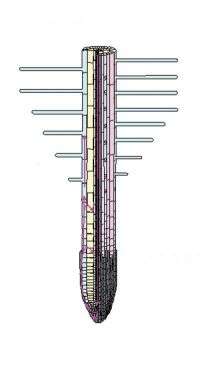More food at lower cost: Important step forward towards increasing crop yields

In the face of climate change, being able to increase crop yields by enabling plants to take up nutrients and water more efficiently becomes increasingly important, as fertiliser and water supplies incur significant energy and environmental costs.
New research from the University of Bristol, published today in Nature Cell Biology, has shown how to increase the length of root hairs on plants, potentially improving crop yields, as plants with longer root hairs take up minerals and water more efficiently.
Angharad (Harry) Jones, a PhD student in Biological Sciences at the University of Bristol, and lead author on the paper, said: "Each root hair is a single, elongate cell and the length of each hair depends on having an adequate supply of the plant hormone auxin. Auxin is used, for example, in hormone rooting powders to encourage cuttings to root. The difficulty has been in understanding how auxin is delivered to the root hairs in order to promote their growth."
Since auxin cannot be observed directly, Jones used a computer model built by physicist Eric Kramer at Bard College, USA, to calculate where auxin was likely to be in plants. The model was based on current knowledge of auxin transport through and around the relevant cells.
What the model showed was very surprising: auxin is not delivered to root hair cells directly, but via the cells next door which act as canals through which the auxin is transported. During transport, some of the auxin leaks out, supplying hair cells with the auxin signal to grow. This new understanding will be crucial in helping farmers to produce food sustainably and to reduce fertiliser waste, which can cause severe damage to ecosystems.
Dr Claire Grierson, senior author on the paper added: "This important new work is an example of 'integrative biology', an innovative, interdisciplinary approach that uses experimental results alongside mathematical models and computer simulations to test ideas that are difficult or impossible to investigate with experiments alone. This approach has produced groundbreaking and surprising insights into a biological mechanism that might otherwise have eluded us."
The results also suggest that increasing the number of root hairs is likely to interfere with auxin supply and cause problems with other important traits like a plant's response to gravity and root branching. The new understanding of how to increase the length of roots hairs, rather than their numbers, will now avoid these kinds of problems.
It was Charles Darwin and his son Francis who, in 1880, first discovered that plants direct their growth towards the light. These observations would later lead to the discovery of auxin.
Source: University of Bristol


















